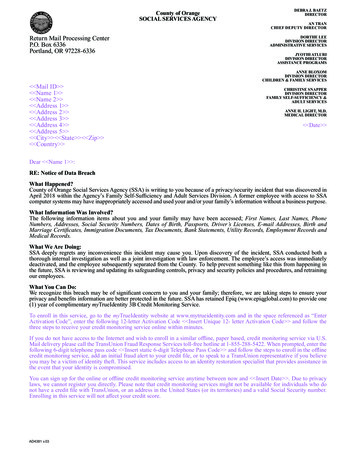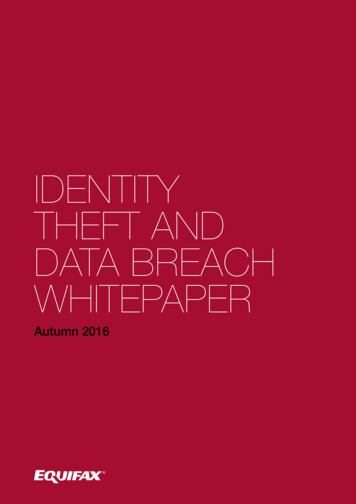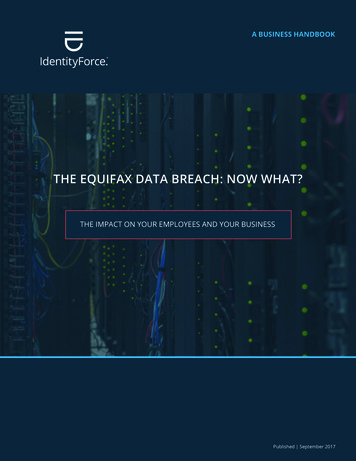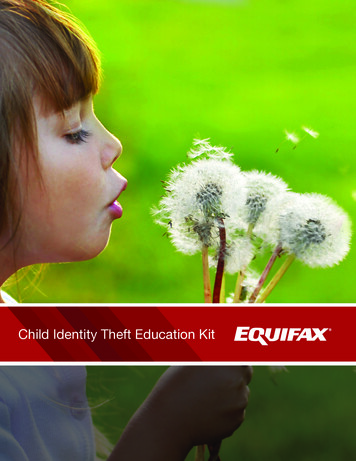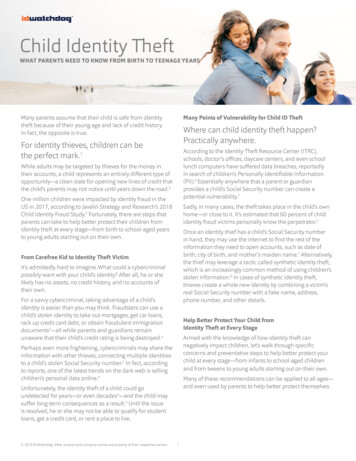
Transcription
Child Identity TheftWHAT PARENTS NEED TO KNOW FROM BIRTH TO TEENAGE YEARSMany Points of Vulnerability for Child ID TheftMany parents assume that their child is safe from identitytheft because of their young age and lack of credit history.In fact, the opposite is true.Where can child identity theft happen?Practically anywhere.For identity thieves, children can bethe perfect mark.1According to the Identity Theft Resource Center (ITRC),schools, doctor’s offices, daycare centers, and even schoollunch computers have suffered data breaches, reportedlyin search of children’s Personally Identifiable Information(PII).6 Essentially anywhere that a parent or guardianprovides a child’s Social Security number can create apotential vulnerability.7While adults may be targeted by thieves for the money intheir accounts, a child represents an entirely different type ofopportunity—a clean slate for opening new lines of credit thatthe child’s parents may not notice until years down the road.2One million children were impacted by identity fraud in theUS in 2017, according to Javelin Strategy and Research’s 2018Child Identity Fraud Study.3 Fortunately, there are steps thatparents can take to help better protect their children fromidentity theft at every stage—from birth to school-aged yearsto young adults starting out on their own.Sadly, in many cases, the theft takes place in the child’s ownhome—or close to it. It’s estimated that 60 percent of childidentity fraud victims personally know the perpetrator.3Once an identity thief has a child’s Social Security numberin hand, they may use the internet to find the rest of theinformation they need to open accounts, such as date ofbirth, city of birth, and mother’s maiden name.7 Alternatively,the thief may leverage a tactic called synthetic identity theft,which is an increasingly common method of using children’sstolen information.6 In cases of synthetic identity theft,thieves create a whole new identity by combining a victim’sreal Social Security number with a fake name, address,phone number, and other details.From Carefree Kid to Identity Theft VictimIt’s admittedly hard to imagine. What could a cybercriminalpossibly want with your child’s identity? After all, he or shelikely has no assets, no credit history, and no accounts oftheir own.For a savvy cybercriminal, taking advantage of a child’sidentity is easier than you may think. Fraudsters can use achild’s stolen identity to take out mortgages, get car loans,rack up credit card debt, or obtain fraudulent immigrationdocuments2—all while parents and guardians remainunaware that their child’s credit rating is being destroyed.4Help Better Protect Your Child fromIdentity Theft at Every StageArmed with the knowledge of how identity theft cannegatively impact children, let’s walk through specificconcerns and preventative steps to help better protect yourchild at every stage—from infants to school-aged childrenand from tweens to young adults starting out on their own.Perhaps even more frightening, cybercriminals may share theinformation with other thieves, connecting multiple identitiesto a child’s stolen Social Security number.2 In fact, accordingto reports, one of the latest trends on the dark web is sellingchildren’s personal data online.4Many of these recommendations can be applied to all ages—and even used by parents to help better protect themselves.Unfortunately, the identity theft of a child could goundetected for years—or even decades5—and the child maysuffer long-term consequences as a result.2 Until the issueis resolved, he or she may not be able to qualify for studentloans, get a credit card, or rent a place to live. 2019 ID Watchdog. Other product and company names are property of their respective owners.1
Infants and Young Children:The Worrying Trend of YoungChildren’s Data Being Soldon the Dark WebFor Sale On the Dark Web: An Infant’s Data Set for 300According to reports, cybercriminals have postedadvertisements in online marketplaces selling children’sidentities.4 In one instance, criminals advertised somethingcalled “infant fullz,” encouraging potential buyers to purchaseit before tax season.5 The term “fullz” is cybercriminal slangfor a full identity kit—essentially everything a thief needsto steal an identity, such as name, address, Social Securitynumber, and date of birth.Security researchers have reported a concerning identity thefttrend, especially for parents of young children. Cybercriminalshave recently begun targeting children—even infants—inorder to take advantage of their clean, unmonitored credit.6xxxxxx, xxxxxxx-xx-xxxxIn some cases, the stolen data is being advertised on the darkweb for the purpose of committing tax fraud, but more often,criminals use it to open credit card accounts, get loans, andstain what would otherwise be the child’s clean credit.5 FOR SALE ······· The price? 300 worth of bitcoin foran infant’s data set, in some cases.⁸ !? xxx-xx-xxxxFresher is typically better in the criminal exchange of datathat often takes place on the dark web, and a young child’sdata may be more appealing to cybercriminals because it isless likely that it has been exploited before.4 If, for example, acriminal can snag a child’s identity before anyone else does,they may get to start from scratch in setting up a credit profileunder the victim’s name for the first time.4- 2019 ID Watchdog. Other product and company names are property of their respective owners.xxx-xx-xxxx2
Fake Dependents Can Be Profitable for Identity ThievesFor a thief, that potential profitmay be worth the gamble.One way that a criminal may attempt to use a child’s stolendata is by committing tax fraud—essentially claiming thechild as a dependent on a fraudulent tax return in order totake advantage of the child tax credit.5 Given that many taxrefunds are issued by the IRS well before the tax form is fullyscrutinized, identity thieves could have enough time to cashin on a fraudulent dependent tax credit—and run.9Steps to Help BetterProtect Your Infantor Young ChildProtect physical informationTry to avoid carrying documents in yourwallet that disclose your child’s SocialSecurity number or other PII.7 Instead,keep important documents locked upat home or in a safe deposit box.Store safely or shred documents thatcontain your child’s informationFor electronic or paper documentsthat you need to keep, choose a safelocation.10 For documents that you candispose of, shred them first.Case in point: an identity thief whopurchases an infant’s data set for 300 worth of bitcoin could then usethat information to potentially earn 1,000 by claiming a dependent on afraudulent tax return.9Provide less information aboutyour child on formsConsider holding back someinformation, such as your child’s SocialSecurity number, middle name, anddate of birth, when filling out forms.7In some cases, you may be able touse your own identifying informationinstead, which can be easier to monitorfor potential problems. Also considerasking if you could use a differentidentifier, or use only the last four digitsof your child’s Social Security number.10Be aware of events that may putinformation at riskPay particular attention to certaincircumstances, such as having anadult in your household who might betempted to use a child’s identity to startover, losing a wallet, purse or importantpaperwork, experiencing a break-in atyour home, or being notified of a databreach at your child’s school, doctor’soffice, or another location.10 2019 ID Watchdog. Other product and company names are property of their respective owners.3Exercise caution on social mediaBe careful when sharing personalinformation online about your child,such as birthday or city of birth, thatcould be of value to an identity thief.7Consider a child credit freezeor credit report lockConsider freezing or locking yourchild’s credit reports until he or sheis old enough to use credit.11 A creditreport freeze or lock restricts accessto your child’s credit file, making itharder for identity thieves to open newaccounts in your child’s name.12Consider filing taxes earlyConsider filing taxes as early aspossible to help prevent criminals fromcashing in on your refund, including adependent tax credit, before you do.13
School-Aged Children: TeachingKids How to Safely Navigatein a Virtual WorldSchool Data Breaches May ExposeStudents’ Personal DataSchools can be a tempting target for cybercriminals, asthey typically store a mountain of Personally IdentifiableInformation of both students and staff members.17The K-12 Cybersecurity Resource Center documented 122cybersecurity incidents that impacted public K-12 schooldistricts in the US in 2018, which equates to one newincident every three days of the calendar year.18 And that maybe just the tip of the iceberg, as it’s likely that manymore school breaches or attacks were either not detectedor not reported.19The internet is an incredible resource for children to learn,communicate with family and friends, and entertainthemselves while you’re busy tackling the latest workemergency. But it can also expose children to both virtualand real-world dangers.While children are gaming, chatting, or surfing the internet,they can stumble onto inappropriate content and images,malicious emails or file sharing programs, or even actualpredators who may use the internet to find and lureheir victims.14Student data was exposed in more than 60 percent of K-12data breaches in 2018, and with the ever-growing adoptionof technology in schools, K-12 cybersecurity incidents areexpected to become both more frequent and potentiallymore significant.18The Internet Can Be a Risky Place for KidsWhen you were a child, your parents may have advised younot to talk to strangers or to be home before dark. But thesedays, kids have to learn how to navigate in an entire virtualworld as well.Tweens and Teens: The Majority of TeensHave Been Bullied or Harassed OnlineBoth adults and children alike are at risk for having theirinformation misused on the web. The difference is that achild likely doesn’t understand what information is safe toshare online, and they may be unaware of the myriad ofscams and malicious content that are pervasive onthe internet.15One type of cyberbullying occurs when a password that achild has previously shared with friends or classmates is usedto break into the child’s social media account. The cyberbullycan then use the account to post embarrassing messages orimages, spread spam, or post links to malicious sites.16In the more frightening scenario of cybercriminals whoactually target children, the criminals may use unique tacticsthat are hard for kids to resist, such as links to fan sites thatcontain malicious links, or offers of music or movies thata child might be tempted to download and could containviruses or malware that represent a security threat.16Sadly, 59 percent of teenagers in the UShave been bullied or harassed online.20 2019 ID Watchdog. Other product and company names are property of their respective owners.Teens may face particularly difficult challenges in the virtualworld in the form of cyberbullying.The most common types of cyberbullying were offensivename-calling and spreading of rumors, but teens alsoreported receiving unwanted explicit images, stalkingbehaviors, physical threats, and having explicit images ofthemselves shared without their consent.204
Steps to Help BetterProtect YourSchool-Aged ChildConsider parental controlsResearch the tools available that canhelp limit, monitor, or filter a child’sinternet use.21 Depending on what’sright for you and your child, you canchoose tools that filter certain content,limit time on device, monitor a child’susage, or even disable outgoingcontent and in-app purchases.Check privacy settingsTalk with your child about theimportance of using the appropriateprivacy settings, especially for socialmedia networks and chat.22 It’srecommended to set strict privacypreferences on chat and video chataccounts, such as whether other userscan see if the child is currently onlineand who can send the child messages.Create a safe screen nameTalk with your child about their screenname for apps and games and whatit reveals about them.22 A safe screenname won’t divulge the child’s fullname, age, where they live, gender,email address, or even seeminglyinnocent information like a sportsjersey number.23 It also shouldn’tcontain any vulgar or suggestivewords as this can attract the wrongtype of attention.Create strong passwords andkeep them privateTeach children never to sharepasswords, even with their friends.16Talk about safe password habits, suchas creating a ”passphrase” that wouldbe difficult for others to guess, andusing different passwords fordifferent accounts.24Talk about what information can beshared—and what shouldn’tKids typically like to share a lot ofpersonal details online, includingpictures, videos, plans, and theirlocation. Talk with your child aboutwhat types of information should neverbe shared, such as their Social Securitynumber, street address, phone number,and financial information.21Be aware of school privacy policiesPay attention to notices from yourchild’s school10 that explains yourrights under Family EducationalRights and Privacy Act (FERPA),including your right to approve thedisclosure of personal information inyour child’s records.25 Don’t forget toalso review the privacy policies for anyextracurricular programs your childparticipates in, as those programscould have websites in which childrenare named and pictured.10Consider opting out of theschool directoryStudent directory information mayinclude your child’s name, address,date of birth, telephone number,email address, and photo. If you wantto opt out of the release of directoryinformation to third parties, it’s bestto put your request in writing.10 If youdon’t opt out, directory informationmay be available to the schoolcommunity as well as to thegeneral public.Talk about how to avoidmalicious linksMalicious links can be found on videosharing sites, in ads or invites and maylead kids to inappropriate or illegalcontent to third-party sites that capturesensitive information.16 Teach kids tobe wary of tempting links, like “make anew friend” or “find out who’s talkingabout you.” 2019 ID Watchdog. Other product and company names are property of their respective owners.5Train them to recognizeinappropriate onlinebehavior by othersEducate your child on how to detectintrusive or predatory behavior online.One option is to role play with themabout what they’d do if someonewas asking nosy questions in personor was standing too close to them.26Then talk about the online equivalentof that inappropriate behavior as wellas actions they should take if theyencounter it.Keep an open line of communicationA myriad of experts—from Google’sSafe Search Kids27 to non-profitKidsHealth28 to the Federal TradeCommission (FTC)29—recommend onekey element in helping kids stay saferonline: open communication with theirparents or guardians.Check their credit at age 16Check whether your child has acredit report close to his or her 16thbirthday.10 If it has errors due to fraudor misuse, you will have time to correctit before the child applies for a job,needs a loan for tuition or a car, orattempts to rent an apartment. If youplaced an earlier credit freeze, you willhave to lift it before the child applies fornew credit.
Graduates and Young Adults:Preparing Kids to Outsmart aLifetime of ScammersThe reality is that students can be a target for identity theft.During this transitional time, their identifying informationmay be in a lot of different places, because of life changes,such as moving out on their own, filling out backgroundchecks to sign a lease or activate utilities, or applying forjobs and completing college applications.33 It’s important toprepare young people for these life events and help themunderstand how the safety of their financial, medical, andpersonal identity may be impacted.These days, it may not be enough to send your high schoolgraduate off to start school or tackle a new job with newclothes, a set of twin sheets, and a shower caddy. The ITRCsays it’s equally as important to arm them with a crosscut shredder, a locking storage box, and knowledge aboutidentity theft and other scams that they may encounterwhile living on their own for the first time.30?x!?!xIn fact, the FTC notes that 20 percent of identity theftincidents reported in its Consumer Sentinel Network DataBook in 2018 were committed against victims ages 29and under.31?!xFinancial Scams Abound on College CampusesAccording to the ITRC, there are several ways that scammerstarget young people, and many of those tactics go hand-inhand with students heading off to college—such asapplying for colleges or employment, moving into a dormor apartment, signing up for utilities, or getting a newcredit card.34College students may be vulnerable to a myriad of scams,including scholarship and financial aid scams, employmentscams, imposter scams in which fraudsters pretend to bea school official or work for another trusted organization,student loan debt relief scams, or even scams related to nonexistent apartments or textbooks.35Big Life Changes May Mean Big Risk forIdentity Theft and ScamsMany students and young people think that identity theftwon’t necessarily affect them, since they may not have a lotof financial assets or great credit scores.32 But as we’velearned in this paper, identity theft isn’t just about stealingmoney—it’s about stealing personal or financial informationto try to open credit card accounts, secure a loan, or commitother fraudulent acts in the victim’s name.32 2019 ID Watchdog. Other product and company names are property of their respective owners.In one example of how criminals may target students, theITRC warns that scammers may try to steal identities fromunsuspecting students through enticing job offers.34 Thesecriminals may prey upon a student’s money, personalinformation, or even physical safety.366
Steps to Help BetterProtect Your Teenageror Young AdultBe cautious with SocialSecurity numbersAdvise your child to consider keepinghis or her Social Security card in alocked, safe place, rather than carryingit.30 Also, they should be thoughtfulabout with whom they share theirSocial Security number.32 For example,some financial institutions let accountholders provide an identifier otherthan a Social Security number whenaccessing or opening an account. Inaddition, most schools now use astudent identification number insteadof a Social Security number.30Sort and shred mail and documentsLearn to spot phishing emailsInstead of letting mail pile up whereothers can easily access it, considerbuying them a shredder, andadvising them to shred all importantdocuments, such as bank statements,credit card offers, and anything thatcontains an account number or SocialSecurity number.32Teach young people to be wary ofemails that “phish” for information.32Phishing emails and texts often try toget victims to click to what appears tobe a legitimate site but is actually awebsite controlled by cybercriminalswhere personal information maybe recorded.Secure laptops and other devicesCheck credit reportsDiscuss how to safely store laptops andother devices in a locking storage box ifthey are left unattended in dorm roomor apartment.30 It’s also a good idea tolog out of secure sites, such as onlinebanking sites, and check that webbrowsers aren’t automatically savinglogin and password combinations forsensitive sites.32Once a young person has establishedcredit, advise them to check their creditreports with the three nationwidecredit bureaus at least annually.30 Theymay not have a report yet if they havenever established credit. If there is acredit report in their name, they shouldreview it to make sure that none of theinformation is a result of fraudulentactivity. If they find suspicious activity,the FTC recommends informing theorganizations where fraud occurredabout the potential identity theft andplacing fraud alerts, so lenders willbe encouraged to take extra steps toconfirm the identity before openingnew credit. They might also considerplacing a security freeze which couldprovide additional protection againstunauthorized access to help betterprotect against identity thieves fromopening new accounts in their name.39Keep a permanent addressfor important mailBe cautious when sharingon social mediaIt may be best to avoid mailingimportant documents to a dorm orapartment where the mailbox maynot be secure.37 Instead, young peopleshould consider using a parent orrelative’s address or getting a postoffice boxYoung people who are comfortablesharing details about their lives onsocial media sites may post a lot ofpersonal details over time.37 Adviseyour child to remember that scammersmay be able to mine social medianetworks for information that couldhelp them answer account securityquestions and hack into various sites.Don’t loan identification, creditor debit cards, or signaturesAs difficult as it can be to say “no”to a friend when they are in need,remind your child that loaning outtheir ID or credit cards, or co-signingfor any cell phone, utility account, carloan, or credit card could put them atunwarranted risk.30Surf and shop wiselyTrain your child to always look forthe “https” and padlock icon onwebsites,32 as sites that don’t useproper encryption may make theman easier target for thieves.38 Advisethem to avoid making any payments onpublic WiFi, as these networks may notbe secure.37 2019 ID Watchdog. Other product and company names are property of their respective owners.7
How to Report aSuspected Problem! I f you believe you or your child has been the victim of identitytheft, report the incident to the FTC at identitytheft.gov. ! I f you believe you have been a victim of tax identitytheft, refer to the IRS fact sheet for taxpayers for moreinformation at www.irs.gov/pub/irs-pdf/p5027.pdf.40! I f you believe your child’s school or district has actedinappropriately with his or her data, file a written complaintwith the US Department of Education.10! I f you or your child sees offensive online content or othercriminal behavior, document the activity and report the issueto local law enforcement or the local office of the FBI.14! If you believe a website collected information from your childor marketed to them in a way that violates the law,21 report itto the FTC at www.ftccomplaintassistant.gov/#crnt&panel1-1.! I f you suspect an online predator, report it to the NationalCenter for Missing and Exploited Children’s CyberTipline atwww.missingkids.org/gethelpnow/cybertipline.A Final Word of Adviceon Better Protectinga Child’s IdentityPerhaps most importantly, when it comes to teachingyour child how to better protect their personal andfinancial information, lead by example.27 One of thebest lessons for a child is to see their parent or guardianmodel good information safety by adhering to the sameground rules that you would like your child to follow. 2019 ID Watchdog. Other product and company names are property of their respective owners.8
Sources CitedCNBC, “How to Protect Your Child From Identity Theft”Federal Trade Commission, “Net Cetera: Chatting with KidsAbout Being Online”121 BI Portland, “FBI Tech Tuesday: Building a Digital DefenseFAgainst Child ID Theft”2Federal Trade Commission, “Kids and Socializing Online”22Javelin Strategy and Research, “2018 Child IdentityFraud Study”Common Sense Media, “Privacy and Internet Safety”3 23ID Watchdog, “Expert Tips for Crafting a Stronger Password:How to Pick Passwords and (Hopefully) Remember Them”24 ZDNet, “The Latest Dark Web Cyber-criminal Trend: SellingChildren’s Personal Data”25 TNW, “The Worrying Trend of Children’s Data Being Sold on theDark Web”264 U.S. Department of Education, “Family Educational Rights andPrivacy Act (FERPA)”5 Parent Info, “Your Child’s Digital Footprint”Identity Theft Resource Center, “One Million Kids Were Victims ofID Theft Last Year”27 The Washington Post, “How to Protect Your Kids—And TheirFuture Credit—From Identity Thieves”286 Safe Search Kids, “How to Property Educate Your Kids on thePossible Dangers Online”7 KidsHealth, “Internet Safety”Federal Trade Commission, “Kids Online”29CNN Business, “Infant Social Security Numbers Are For Sale onthe Dark Web”8 I dentity Theft Resource Center, “College Students andIdentity Theft”30 onsumer Reports, “Why Child Identity Theft Is a GrowingCConcern During Tax Season”9Federal Trade Commission, “Consumer Sentinel NetworkData Book 2018”31 Federal Trade Commission, “Child Identity Theft”10The Balance, “College Identity Theft: A Growing Problem”32Equifax, “Freezing Your Child’s Credit Report: FAQ”11Identity Theft Resource Center, “Taking the Leap to Adulthood—What Graduates Should Know About Identity Theft”33 SA Today story from Equifax, “Why Should I Lock My EquifaxUCredit Report?”12Identity Theft Resource Center, “Back to School,Back to Scams”34 I D Watchdog, “Tax-related Identity Theft: Why You May Want toConsider Filing Your Tax Return Early”13ID Watchdog, “Back to Campus: 9 Scams for College Students tobe Aware of as They Head Back to Campus”35 The United States Department of Justice, “ChildrenInternet Safety”14 University of Missouri, “Avoid Job Scams”36Internetmatters.org, “Privacy & Identity Theft Advice Hub”15Consumer Reports, “College Students Face a Greater Risk ofIdentity Theft”37 ConnectSafely, “A Parents’ Guide to Cybersecurity”16EdScoop, “Human Error to Blame in Vast Majority of EducationData Breaches”38 The K-12 Cybersecurity Resource Center, “K-12 Cybersecurity2018 Year in Review”39 Education Week, “Schools Suffered at Least 122 CybersecurityIncidents Last Year”40 17 U.S. News & World Report, “The Very Best Ways to PreventCredit Card Fraud”18 Consumer Financial Protection Bureau, “What Do I Do If I ThinkI Have Been a Victim of Identity Theft?”19 Internal Revenue Service, “Identity Theft Informationfor Taxpayers” ew Research Center, “A Majority of Teen Experienced SomePForm of Cyberbullying”20 2019 ID Watchdog. Other product and company names are property of their respective owners.9
Child Identity Fraud Study.3 Fortunately, there are steps that parents can take to help better protect their children from identity theft at every stage—from birth to school-aged years to young adults starting out on their own. From Carefree Kid to Identity Theft Victim It's admittedly hard to imagine. What could a cybercriminal


